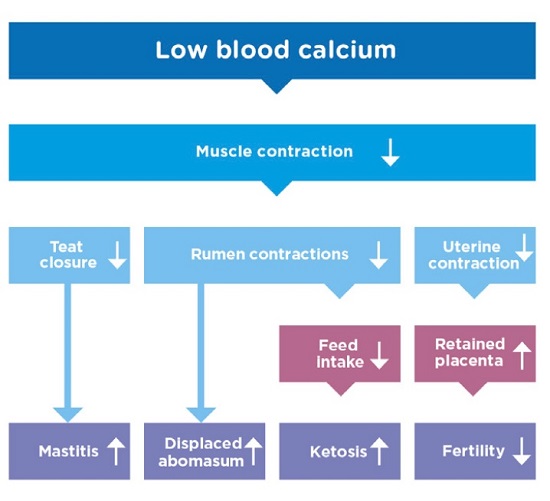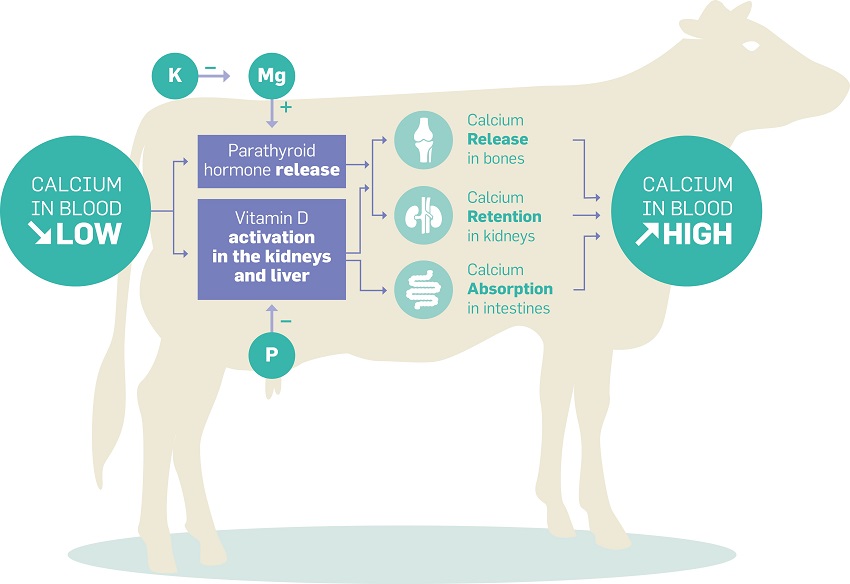Why high phosphorus in dry cow diets is detrimental to health
More is not always better. This applies to many things but especially to dry-cow rations. Successful, problem-free lactation, as well as calf rearing, starts during the dry period. Unfortunately, many things can go wrong during this period. One of them is phosphorus feeding. While it's increasingly recognised that it's better to feed less phosphorus during the dry period, the opposite is frequently advised. This article explains why it really is better to feed low phosphorus during the dry period.

First things first: getting the basics right
Before diving into mineral and trace element nutrition, we need to make sure the dry-cow ration meets basic requirements: A palatable ration to achieve sufficient feed intake, the right energy level to keep the body condition stable during the dry period and enough protein for maintenance, recovery of the udder tissue and growth of the calf. To formulate an optimal dry-cow ration, all ration components must be analysed, including minerals and trace elements.
Determining minerals in feed is essential to calculating the correct dietary cation-anion balance (DCAB) in the ration (ratio of potassium, sodium, sulphur and chloride). But optimal dry cow mineral nutrition goes beyond the right DCAB strategy - it's important to check other minerals levels such as phosphorus and magnesium. As can be seen in the figure below, magnesium has a positive influence on the hormonal regulation of calcium levels in the cow's blood, but is in turn negatively affected by high potassium levels.
What role does phosphorus play in calcium metabolism?
Phosphorus plays an important but negative role in calcium metabolism. A higher intake of phosphorus limits the cow's absorption of calcium. Higher phosphate concentrations cause reduced production and increased degradation of 1.25-dihydroxyvitamin D and stimulate parathyroid hormone (PTH) release. In this vitamin D deficient state, calcium absorption in the intestines decreases and there's an increase in the secretion of PTH. This stimulates production of 1.25-dihydroxyvitamin D but in this phase, it results in excessive urinary phosphate loss.
We now have a situation where different metabolic systems are working against each other. The cow cannot solve this herself because a low feed intake causes a low intake of much-needed phosphorus and calcium. Intensive treatment is required but with a chance of failure. That’s why it's really important to prevent cows reaching this situation.
Lower phosphorus is not only better for cow health, it’s also better for the phosphorus balance on your farm and can sometimes lead to cost price reduction.
Low phosphorus dry cow ration in practice
The cow’s phosphorus requirement during the dry period is just 2-3g per kilogramme of dry matter (DM). Formulating a low-phosphorus diet for dry cows can involve additional costs, but with clear health and economic benefits in the long term, you will find that this money is well spent. Indeed, field studies carried out by our company confirm the need for low-phosphorus diets. They show that reducing phosphorus by 1g per kilogramme of DM during close-up can lead to 19% fewer cases of subclinical hypocalcaemia (SCHC). The importance of preventing subclinical hypocalcaemia (SCHC) is shown in the figure below.
In addition, you will see that when you start lowering phosphorus in a dry-cow ration , you will usually use feedstuffs that are low in phosphorus but also have a favourable energy-to-protein ratio and are low in potassium. This means that this ration meets all the preconditions to optimally prepare cows for the next lactation. Using this kind of ration, you will prevent a lot of risks during calving, keeping it safe and simple. In conclusion, lower phosphorus is not only better for cow health, it's also better for the phosphorus balance on your farm and can sometimes lead to cost price reduction. The result is a bigger chance of a trouble-free start to lactation.
If you want to know more about our optimal dry-cow approach, please contact me
About the author

Thijs Hunink
Specialist Ruminants





